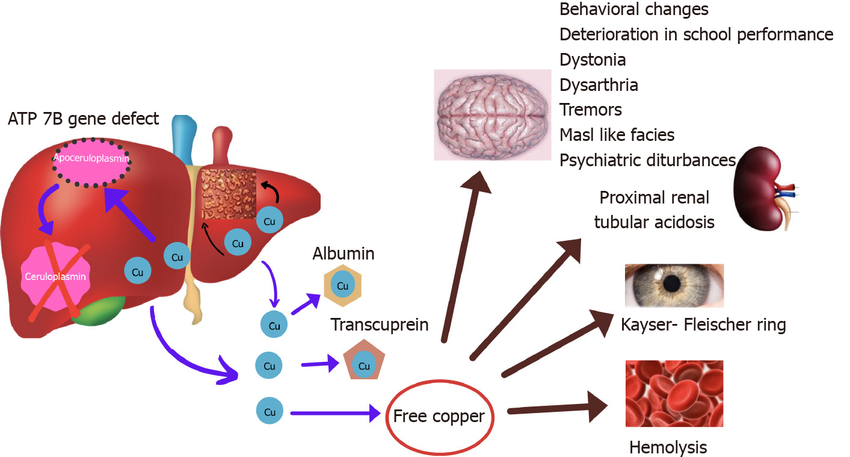
Wilson’s disease is a genetic disorder that hinders the body’s ability to eliminate excess copper, leading to toxic accumulations in vital organs, especially the liver and brain. First described in the early 1900s, this condition can be life-threatening if untreated but is manageable with early intervention and consistent care. Despite its rarity, understanding Wilson’s disease can significantly improve outcomes for those affected.
Causes of Wilson’s Disease
Wilson’s disease stems from mutations in the ATP7B gene, which regulates copper metabolism in the body. This mutation disrupts copper excretion into bile, causing excessive buildup in organs.
- Inheritance: It follows an autosomal recessive pattern, requiring both parents to pass on the defective gene.
- Copper Overload: The inability to remove copper results in toxic levels, damaging tissues over time.
Indications of Wilson’s Disease
The early signs of Wilson’s disease may be subtle and overlap with other health conditions:
- Persistent fatigue and weakness.
- Jaundice or yellowing of the skin and eyes.
- Unexplained abdominal swelling or pain.
- Behavioral changes, including irritability or depression.
Symptoms of Wilson’s Disease
Symptoms vary depending on the organs affected, often appearing between ages 5 and 35:
- Liver Symptoms: Hepatitis, cirrhosis, and acute liver failure.
- Neurological Symptoms: Tremors, muscle rigidity, slurred speech, and poor coordination.
- Psychiatric Symptoms: Depression, anxiety, mood swings, and cognitive decline.
- Eye Symptoms: Kayser-Fleischer rings, visible copper deposits around the cornea.
Prevention Strategies of Wilson’s Disease
While the genetic nature of Wilson’s disease prevents complete avoidance, the following strategies can minimize its impact:
- Genetic Counseling: For families with a history of the condition.
- Early Screening: Regular testing for at-risk individuals.
- Copper-Restricted Diet: Limiting foods high in copper like shellfish, nuts, and liver.
- Consistent Monitoring: Lifelong follow-ups with a healthcare provider.
Myths and Facts About Wilson’s Disease

- Myth: Wilson’s disease only affects the liver.
Fact: It also impacts the brain, eyes, and other organs. - Myth: Only adults can develop the condition.
Fact: Symptoms can appear in childhood or adolescence. - Myth: Diet alone can treat Wilson’s disease.
Fact: Medical treatments are essential alongside dietary adjustments.
Treatments and Therapy
Medication-Based Treatments
- Chelation Therapy: Medications like penicillamine and trientine bind copper, helping the body excrete it.
- Zinc Therapy: Reduces copper absorption from food.
Surgical Treatments
- Liver Transplantation: Necessary for individuals with irreversible liver damage.
Physical Therapy and Rehabilitation
- Improves movement and coordination for those with neurological symptoms.
Lifestyle and Behavioral Interventions
- Copper-restricted diets and regular hydration support overall management.
Alternative and Complementary Medicine
- Practices like acupuncture and meditation can relieve stress but should complement traditional treatments.
Psychotherapy and Counseling
- Helps patients cope with emotional and psychological challenges associated with chronic illness.
Immunizations and Vaccines
- Protects against infections in immunocompromised individuals.
Stem Cell Therapy
- Still experimental but shows promise for repairing liver damage.
Gene Therapy
- Research is underway to correct the defective ATP7B gene, offering hope for a cure.
Top 20 FAQ on Wilson’s Disease

1. What is Wilson’s disease?
A genetic disorder that leads to toxic copper buildup in the body, affecting organs like the liver, brain, and eyes.
2. How is it diagnosed?
Wilson’s disease is diagnosed through:
- Genetic testing.
- Blood tests (e.g., serum ceruloplasmin).
- Liver function tests.
- Eye exams for Kayser-Fleischer rings.
3. What tests confirm the disease?
Tests that confirm Wilson’s disease include:
- Serum ceruloplasmin levels.
- 24-hour urine copper test.
- Liver biopsy to measure copper content.
4. Can it be cured completely?
While there’s no permanent cure, symptoms can be effectively managed with lifelong treatment.
5. Who is at risk?
Individuals with a family history of Wilson’s disease or genetic mutations in the ATP7B gene are at higher risk.
6. Are there lifestyle changes needed?
Yes, necessary changes include:
- Following a copper-restricted diet.
- Regular medical checkups.
- Consistent adherence to prescribed medications.
7. What are Kayser-Fleischer rings?
These are copper deposits visible around the cornea during an eye examination and are a key diagnostic indicator.
8. How does it affect the brain?
Wilson’s disease can cause:
- Neurological symptoms like tremors and speech difficulties.
- Psychiatric issues such as depression and mood changes.
9. Can it cause infertility?
Yes, untreated Wilson’s disease may lead to hormonal imbalances affecting fertility.
10. How is it managed during pregnancy?
With careful monitoring, medications like zinc therapy are adjusted to ensure safety for both the mother and the baby.
11. What is the role of zinc in treatment?
Zinc therapy reduces intestinal copper absorption, preventing further accumulation.
12. Are there home remedies?
Home remedies like maintaining a copper-restricted diet and staying hydrated can support medical treatments but are not sufficient alone.
13. What foods should I avoid?
Foods high in copper to avoid include:
- Shellfish.
- Organ meats.
- Nuts.
- Chocolate.
- Mushrooms.
14. How long does treatment last?
Treatment is lifelong and requires strict adherence to medications and regular monitoring.
15. What happens if untreated?
If untreated, Wilson’s disease can lead to severe liver damage, neurological complications, and death.
16. Can children develop it?
Yes, symptoms may appear as early as five years old, though they commonly manifest in adolescence.
17. Does it cause fatigue?
Yes, fatigue is a frequent symptom due to liver dysfunction and copper-related toxicity.
18. Is genetic testing mandatory?
While not mandatory, genetic testing is strongly recommended for families with a history of the disease.
19. Are there new treatments available?
Research into gene therapy, stem cell therapy, and advanced medications is ongoing, offering hope for improved treatment options.
20. Where can I get support?
Support is available through:
Advocacy groups focused on Wilson’s disease and rare disorders.
Specialized medical centers.
Online forums for patients and caregivers.
Conclusion
Wilson’s disease is a challenging yet manageable condition with timely diagnosis, appropriate treatments, and lifestyle adjustments. Increased awareness and regular monitoring can drastically improve the quality of life for those affected. If you or a loved one are at risk, seek medical advice early to prevent complications.
Awareness is the first step toward wellness. Take action today!
Related video: